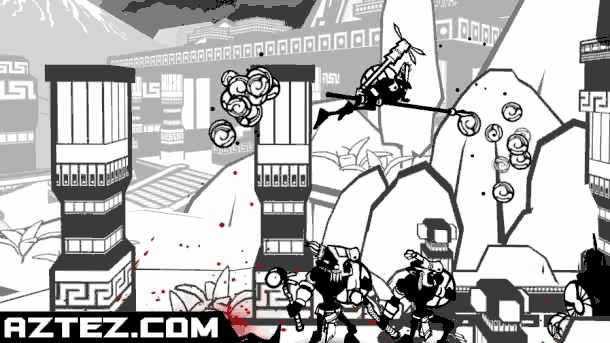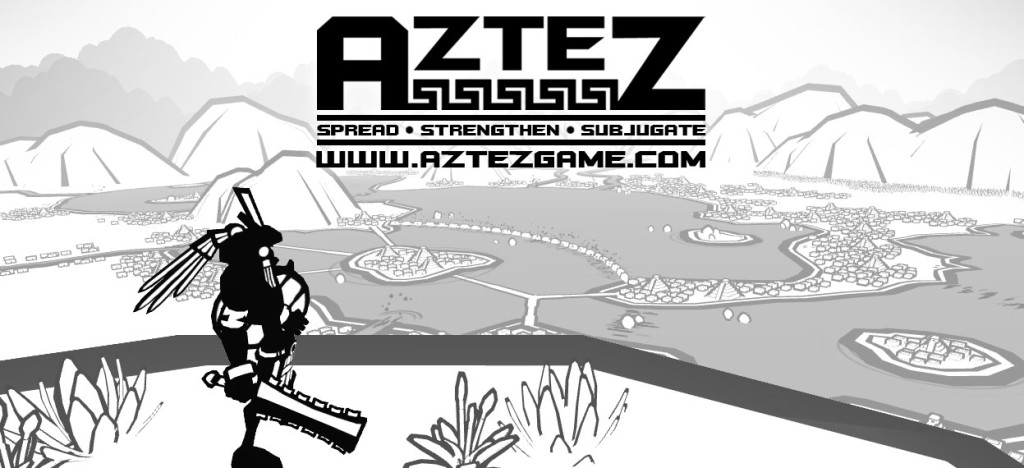Last updated on April 23, 2014
Regarding Aztez, I’m incredibly angry. No, not about the game – it’s clearly magnificent and deserving of your time. Rather, I’m disappointed that I could not find Team Colorblind’s booth until ten minutes before the Expo Hall closed. There can be no greater pain than to miss out on the game that you specifically searched high and low to find, only to completely miss it. There’s nothing more frustrating than that!
And heck, they even handed me a map right when I walked into the BCEC. That says more about my ability to intuit directions and not get lost more than anything!
I first learned about Aztez from a cursory search of the Internet. As you know, I love Bayonetta and Ninja Gaiden with equal fervor. The character-action game remains one of my favorite genres, and I imagine that won’t change any time soon. Further, I discovered Aztez’ development blog, which contains a rather exhaustive explanation of the good/bad parts of game combat design. Heck, they even give Bayonetta props, which is enough to endear me to Aztez right off the bat.
So what is this thing? Aztez is a 2.5D action-combat game with turn-based strategy elements…or so I gather. What I experienced came down to a five minute timed survival mode where enemies would continually spawn from every direction. Frankly, Aztez is the sort of game that you need time and concentration – unfortunately, we had to settle for a loud, large convention hall and several people waiting behind me. You will just need to settle for my impressions and vast repository of personal experience with the genre.
Aztez takes more than a few cues from God of War, but mostly in the right ways. The black/white/grey/red aesthetic allows each and every hit to cause impact visually; subtle cues like a controller shake and a slight pause (for emphasis sake) just add to those visual flourishes. Aztez makes an impression on your psyche precisely because the design intends to make every individual movement enjoyable.
If it were limited to that, then I could just pack my bags right here and end it. But Aztez definitely takes cues from other games in its wheelhouse (fitting, given the number of bat-like bludgeoning weapons on display). Each weapon has basic strings arising out of the traditional weak/heavy attack paradigm, and holding heavy will launch enemies into the air. God of War’s grab attack returns, along with your standard juggles, dashes, and strikes. Dodges feel very similar to God of War, except I could actually figure out the invincibility frames in a short time frame. Clearly, that’s the sign of a well-thought defense right from the start.
Even so, I found Aztez’ combat functioned pretty brilliantly. The best feature came from a relatively free-form combo system. Think of its mash flow as incredibly free-form. Unlike Bayonetta, wherein the speed renders most of your options rather moot (unless you concentrate really hard when playing for score), Aztez moves slow enough that you can recognize, and input, the command you want and/or need. If I want to launch, I can launch; if I want to do a gap-timed attack, then I can pause for a short second to get the launcher out. There was absolutely no time at which I felt hampered by pre-formed combo strings or slow attacks, other than my own incompetence and/or tiredness.

On that note, there’s a wide variety of weapons. Its predecessors only allowed for switching between two different weapon sets, but Aztez lets you freely switch from among its arsenal right off the bat. The d-pad (think an Xbox 360 controller) lets you swap any weapon with a simple touch of the pad, and you flow right into the combo string of your choice given that weapon’s movelist. I realized this after watching other people play when some guy caused a spear to emerge out of thing air. This probably explains why I played it again…
Really, the whole concept of having a full arsenal makes me happy. That’s something I wanted from character action games for a long time, and it’s absolutely marvelous to see a system exist without (at least for the moment) a patronizingly long ability unlock process. We shall see about that, but I’d just be happy messing with the survival mode either way! I have a feeling this might just be too intimidating for most, and merely exists for demo purposes, but here’s to hoping for a mode that allows it.
I should also add that there’s not a single quicktime event in sight, which makes my wrists scream with joy. I don’t need carpal tunnel syndrome, thanks much!
In sum, Aztez as it stands provides you with a rather impeccable combat system that I merely observed rather than understanding. I would just love to be locked in a room for an hour with this game, just to figure out all the weird nuances, cancels, strange glitches, and whatever other optimal methods I can discover just through experimentation. That, after all, is the point of these in-depth mechanics, right? I call it experimentation within a limited set of rules and systems. Limitations create great art, and further create great individual expression. Give players lots of interesting, yet not dominating, tools, and let them do the rest.
Only two problems remain, then. What’s the strategy framing device for all this fighting? I’m sure it will interest me, but will it add anything or just be there? I have no indications either way for this one, so who is the say? On the other hand, I complain that I can’t just play it right now, and that I barely had time to really do anything with it at PAX East. I’m not sure whether this sort of game really functions well in an expo environment, quite honestly, though I hope other people feel the same way I do about Aztez.
I suppose we could also say that, yes, Aztez is incredibly violent and it makes that violence satisfying. I don’t have a problem with it, but you might. And to that point, I use 1 Corinthians 6:12 for my argument:
All things are lawful for me, but not all things are profitable. All things are lawful for me, but I will not be mastered by anything.
I am not mastered by a lust for violence, though you might be; I just like how the game plays. The exterior elements add to the rules and layers underneath the initial attraction. Maybe we just need to take a step back every once and a while, say “this is fun”, and just let it ride. I certainly will!


